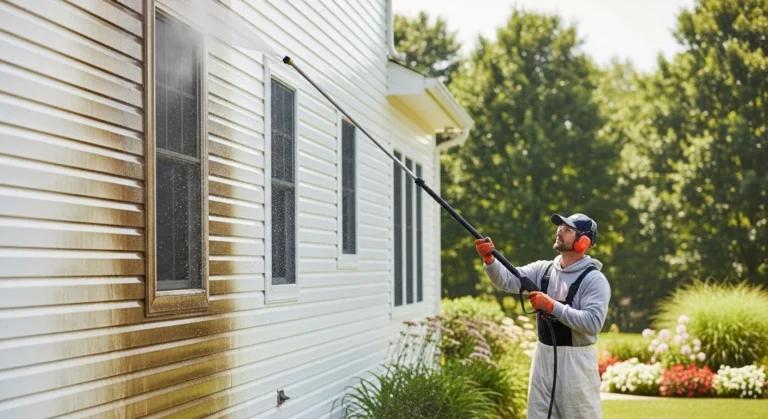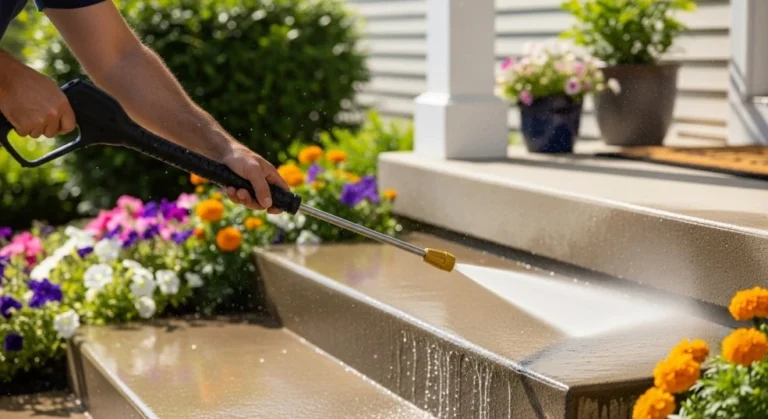Pressure washing is a process that uses less than ten minutes to convert discarded pieces of a surface into shining ones. A lot of homeowners, however, make very expensive mistakes that are beyond repair on the property.
This guide will be useful as it exposes the most frequent pressure washing mistakes and offers effective ways to counter them. You will find out how you can keep your surfaces safe, but with professional cleaning results each time.
Following are the few pressure washing mistakes that one should avoid:
Using Excessive Water Pressure on Delicate Surfaces
The idea of high-pressure is the quickest method to eliminate that hard-to-break dirt and grime. Most individuals would think that their maximum pressure settings would obtain the most favourable cleaning possible.
But, too much pressure may actually destroy fragile surfaces such as wood decking and vinyl siding. Different materials need certain pressure to avoid cracking, gorging, or deteriorating with time.
Neglecting to Test Pressure Settings Before Starting
The majority of pressure washers come with various pressure settings to handle various cleaning applications and surfaces. The testing phase is omitted many times, and the finished goods have damaged surfaces that later have to be restored at a heavy cost.
Good operators will have a go at checking their pressure settings on a non-obvious spot first before going in full blast. This small precaution saves expensive errors and guarantees the best results of cleaning any project.
Holding the Nozzle Too Close to Surfaces
The proximity of your pressure washer nozzle to the surface is majorly important in cleaning. The nozzle, when held too near, concentrates the water pressure in a small area, which is damaging.
This occurs because being at the right distance does not cause damage to the surface, but excellent results are associated with the process of cleaning. A majority of surfaces need optimum cleaning at 12 to 18 inches away.
Choosing the Wrong Nozzle Type for Your Project
The pressure washers use different types of nozzles to perform different cleaning interventions on various surfaces. A mistake in nozzles can be either damage to the surfaces or insufficient cleaning power.
Red nozzles develop focused streams that are ideally used to wash out concrete and masonry. Yellow nozzles provide medium pressure, which can be used in most general house cleaning.
Ignoring Weather Conditions During Pressure Washing
Pressure washing is highly dependent on weather conditions, and it can be very dangerous to work outdoors, especially in stormy conditions. In windy situations, water and contaminants can be dispersed in the opposite direction into the face of the operator or on surrounding surfaces.
Due to the low temperatures, the water may freeze rapidly, and this may lead to slippery surfaces that may be dangerous. Warm, sunny days lead to quick evaporation, which may result in soap marks and wet footprints.
Skipping Pre-Treatment for Stubborn Stains and Mildew
It is a common belief that pressure washing should be able to eliminate any form of stain and accumulation. There are, however, some stains that should be pre-treated chemically to be effectively removed through pressure washing.
Mildew, oil stains and rust need a special cleaning solution to apply prior to initiation of the pressure cleaning. Before treatment dissolves stubborn contaminants, it is easy to discard them using only water pressure.
Read More: Summer Maintenance Tips: Keep Your Driveway & Walkways Spotless
Essential Safety Precautions Every Pressure Washer User Should Follow
The most important thing when handling any form of pressure washing equipment is safety. Most accidents were caused by the operators omitting the least precautions and protective gear. These are the most significant safety precautions that any pressure washer user should observe:
- Use safety goggles whenever working so that your eyes are not exposed to flying particles and water
- Wear non-slipper shoes during cleaning to avoid falls on wet surfaces and floors.
- Water sources should also be avoided as far as electrical connections are concerned in order to avoid a fatal electric shock.
- Never direct the pressure washer at humans, animals, or cars within the premises.
- The electricity must be unplugged prior to any maintenance or the replacement of nozzles on the equipment.
- Before using any pressure washing equipment, read the safety instructions of the manufacturer fully.
- Always keep a proper footing and balance as you work with the pressure washer during your project.
Improper Cleaning Solution Application and Mixing
Numerous cleaning applications in pressure washing use special cleaning agents to get the best efficiency and protection of the surface. Improper combining of cleaning chemicals may harm a surface or make a cleaning activity very inefficient during the process.
When using cleaning solutions with water in the pressure washing process then it is always important to follow the manufacturer’s instructions. Applying an excess chemical may ruin the surfaces, whereas an insufficient amount would not offer sufficient cleaning power.
Moving Too Quickly Across Surfaces During Cleaning
Pressure washing projects done in a hurry tend to have an uneven clean and leave spots uncleaned. When a person moves too fast, they do not allow the water pressure to clear dirt and grime deposits.
It is very necessary to maintain steady overlapping passes, ensuring the consistency of the cleaning results on the surfaces being cleaned. Do not be in a hurry to finish your pressure washing project, but pace yourself so that you work strategically.
Transform Your Cleaning Results With Proper Technique
These typical pressure washing mistakes are to be avoided so as to preserve your property and give it professional results. It is important to remember that the right technique is more powerful than raw force when you need to clean up various surfaces successfully.
Begin with low-setting pressure and adjust accordingly for the hard-to-reach places. Make sure that you always take caution and safety gear, and preparation prior to commencing any pressure washing job around your house.


